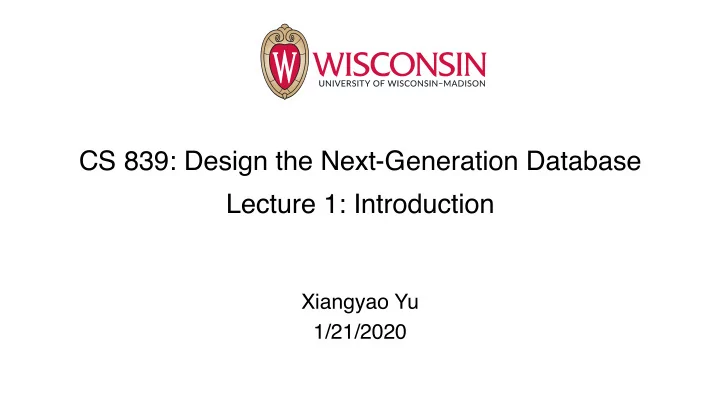

CS 839: Design the Next-Generation Database Lecture 1: Introduction Xiangyao Yu 1/21/2020
Who am I? Xiangyao Yu • Pronounced like Shiang-Yao Yu. Assistant Professor in Computer Science PhD (in computer architecture) and postdoc (in databases) at MIT Research interests: • Transaction processing • New hardware for databases • Cloud databases
Today’s Agenda What is this course about? Course logistics Class projects
A brief history of database systems
Single-Core, Disk-Based (1970s – 2000s) Single-core Data stored in HDD CPU Main memory is a “cache” Memory Hard Disk (DRAM) Timesharing across users Drive (HDD)
Distributed, Disk-Based (1980s – 2000s) Network Shared-nothing architecture Servers communicate over CPU CPU CPU network … Memory Memory Memory Can scale out to thousands HDD HDD HDD of servers
Multicore, In-Memory (2000s – today) Network Multicore processors Data stored in memory • Memory is cheaper • Memory capacity increases … Memory Memory Memory HDD HDD HDD
What Is Next? 1. New processing units: 2. New memory/storage Multicore GPU FPGA Accelerator SSD NVM HBM Network … Database system today RDMA SmartNIC Disaggregation FaaS 3. New network technology 4. Cloud architecture
What Is Next? 1. New processing units: 2. New memory/storage Multicore GPU FPGA Accelerator SSD NVM HBM Next-generation databases have new hardware and system architecture RDMA SmartNIC Disaggregation FaaS 3. New network technology 4. Cloud architecture
1. New Processing Units Multicore GPU FPGA, accelerator
1. New Processing Units – Multicore CPU Core count will continue increasing -> scalability challenges
1. New Processing Units – GPU Graphics processing units (GPU) have massive parallelism but limited memory capacity
1. New Processing Units – Accelerators Oracle software in silicon FPGA Accelerators are effective for compute bound applications
2. New Memory/Storage Non-volatile memory (NVM) High Bandwidth Memory (HBM) Process in Memory (PIM) / Smart SSD
2. New Memory/Storage – NVM
2. New Memory/Storage – HBM High bandwidth memory (HBM) has much higher bandwidth than DRAM
2. New Memory/Storage – PIM/SmartSSD Pushing computation closer to data -> reduces data movement
3. New Network Technology Remote direct memory access (RDMA) Smart NIC
3. New Network Technology – RDMA Remote direct memory access (RDMA) networks reduce latency
3. New Network Technology – Smart NIC Pushing computation into the network
4. Cloud Architecture Resource disaggregation Function-as-a-Service
4. Cloud Architecture – Resource Disaggregation
4. Cloud Architecture – FaaS
Next-generation databases 1. New processing units: 2. New memory/storage Multicore GPU FPGA Accelerator SSD NVM HBM Next-generation databases have new hardware and system architecture RDMA SmartNIC Disaggregation FaaS 3. New network technology 4. Cloud architecture
Goals If you work on databases: Take this course to learn future database systems/hardware If you work on computer architecture: Take this course to get familiar with an important application Otherwise: Take this course to learn both fields
Grading • Paper review: 20% • In-class discussion: 20% • Project proposal: 15% • Project final report: 30% • Project presentation: 15%
Lecture Format Syllabus: pages.cs.wisc.edu/~yxy/cs839-s20/ Reading: 1 paper per lecture (can skip 3 times) Upload review to https://wisc-cs839-ngdb20.hotcrp.com before 9am BONUS : review for optional papers 40 min: Instructor presents the paper 30 min: Group discussion, submit discussion summary
Group Discussion Discuss the provided topics • What if we relax assumption X? • What if metric Y of the hardware improves? • How does the technique extend to application Z? Share conclusions with the class Summarize your discussion and upload to https://wisc-cs839- ngdb20.hotcrp.com Brainstorm ideas for the course project
Course Project In groups of 2—4 students Option 1: Research project towards top conference paper Option 2: Survey for a particular area A list of project ideas will be provided Encouraged to propose your own ideas
Resources CloudLab https://www.cloudlab.us/signup.php?pid=NextGenDB Chameleon https://www.chameleoncloud.org Email me if you need special hardware (e.g., GPU, NVM, RDMA, etc.)
Deadlines Form groups: Feb. 27 Proposal due: Mar. 10 Paper submission: Apr. 23 Peer review: Apr. 23 – Apr 30 Presentation: Apr 28 & 30 Camera ready: May 4
Before next lecture [optional] Submit review for What's Really New with NewSQL?
Recommend
More recommend